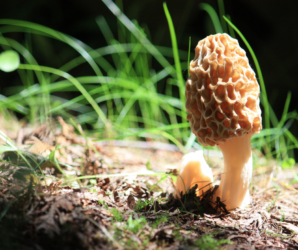 While the majority of Kentucky’s wild edible mushrooms are found during the summer and fall, spring is the time to find the mushroom that foragers may prize the most: the morel. All mushrooms require a specific soil moisture and temperature level to fruit. morel mushrooms (Morchella Sp.) are no exception, typically fruiting after a heavy rain when soil temperatures hover around the low 50-degree mark. They are often found in wild areas with ample sunlight.
While the majority of Kentucky’s wild edible mushrooms are found during the summer and fall, spring is the time to find the mushroom that foragers may prize the most: the morel. All mushrooms require a specific soil moisture and temperature level to fruit. morel mushrooms (Morchella Sp.) are no exception, typically fruiting after a heavy rain when soil temperatures hover around the low 50-degree mark. They are often found in wild areas with ample sunlight.
Try looking in river bottoms, or in recently burned, clearcut, or partially cut forest. A good bet is looking at the base of hickory, oak, elm, ash, tulip poplar, or sycamore trees. While morels are relatively easy to identify, and are generally very safe for foragers, it’s important to familiarize yourself with “false morels”. These mushrooms belong to a totally distinct genus (Gyromitra) from true morels, and several species within that genus are toxic to humans when consumed. False morels tend to be a red, purple, or brown color, whereas true morels are typically a yellow, tan, or grey color. Apart from color differences, one surefire way of differentiating one from the other is to cut the mushroom in half vertically. True morels are hollow on the inside, while false morels have “cotton-like fibers” or chunks of tissue running throughout.
While mushrooms hunting may not be very accessible to the public (we do not allow it at Bernheim), there are several areas within the state where foraging is permitted. Any Wildlife Management Area (WMA) operated by the KY Department of Fish and Wildlife Resources, as well as any National Forest, is fair game to harvest mushrooms. Locally, you can choose between Mammoth Cave National Park, Otter Creek WMA, or Taylorsville Lake WMA. Always check local regulations before harvesting anything from the forest. When harvesting from a patch of mushrooms, it’s important to leave a few individuals behind to complete their life cycle by releasing spores, which are essentially the seeds from which a new generation will grow. Responsible harvest will allow for mushroom populations to replenish, and will aid in the continued right to forage on public lands where it is currently permitted. Again, foraging within the confines of Bernheim Forest is not allowed. Please see above recommendations when seeking a piece of land to find some tasty morels.
-Patrick Likens


